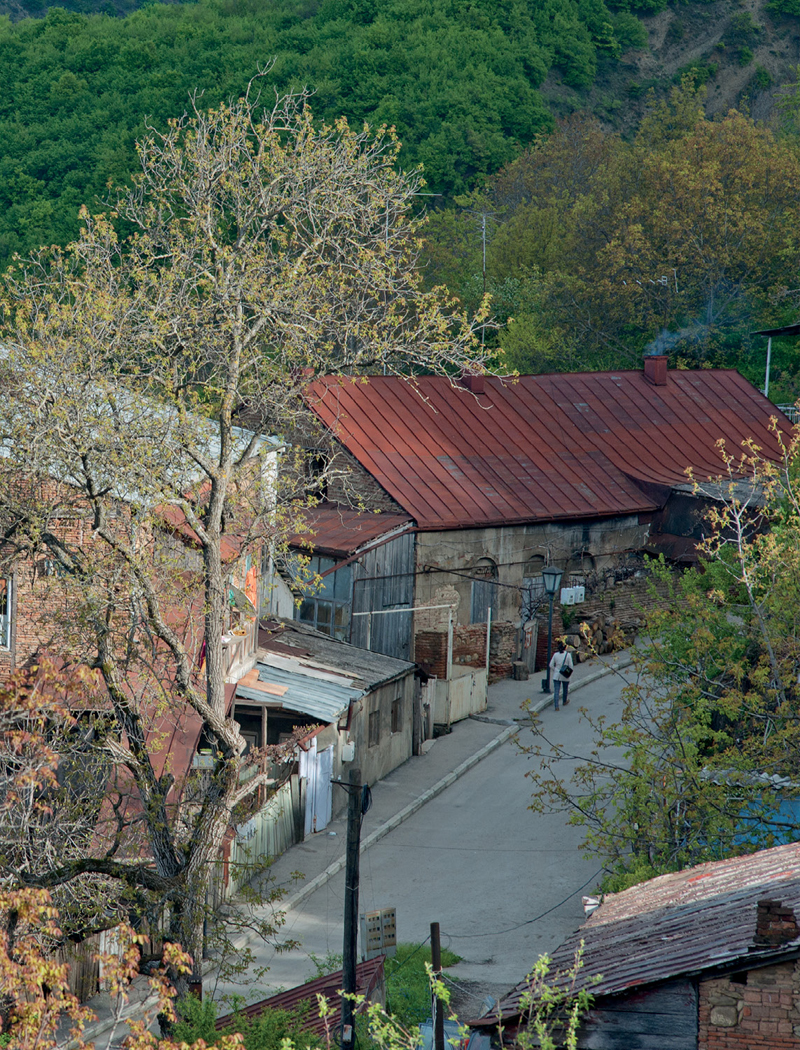

Sighnaghi, Georgia—The Kakheti region in eastern Georgia is famous for its wine and for its beautiful small towns and villages. The towns date back many centuries and were built on hillsides in what would have been, in earlier times, easily defensible locations. Like Sighnaghi, most have spectacular views of the snowy peaks of the Caucasus.
As I set out to explore the Persian-influenced cuisines in the region, it seemed right to me to include Kurdistan, the autonomous part of Iraq that is predominantly Kurdish and lies along Iran’s western border. Though the Kurds of Kurdistan are citizens of Iraq, they are not Arab and they share more culture with Persians than with their Arab fellow citizens: Kurds and Persians speak languages that are closely related (they’re all in the Iranic language family). And there’s a large Kurdish population on the Iranian side of the border with Kurdistan.
As I mentioned in the Introduction, Iran is a kind of bridge between East and West. It is neither Arab nor Turkish, and it lies between the worlds of largely Turkic central Asia and the predominantly Arab Middle East. For centuries, until it was conquered by the Arabs in the seventh century, the country was the center of an empire that fought with the Greeks, Romans, and Byzantines for control of Turkey and the Eastern Mediterranean.
The Caspian Sea coast, which marks part of the country’s northern border in a curve, is very humid, with hot summers and cool, damp winters. It’s an ideal climate for growing tea, rice, and fruits. West of the Caspian Sea, Iran has borders with Azerbaijan and with Armenia, as well as a short border with Turkey. That part of Iran is also the most culturally diverse, as large populations of Azeris, Assyrians, and Kurds, often subject to persecution of various kinds, have lived there since time immemorial. The major cities are Tabriz, a predominantly Azeri town, and Urumiyah.
In the hills that border western Iran, the majority population is Kurdish, close cousins of the Kurds who live across the border in Iraqi Kurdistan. The climate is harsh, with long winters, but in summer, flocks of sheep and goats and crops of wheat and vegetables flourish in the fertile valleys and hills. Farther south along the border with southern Iraq, the population gives way to a mix of various Arab populations and Lurs, some of them nomadic, some settled. (This is the region that was most damaged, and from which many Iranian families fled, during the Iran-Iraq War from 1980 to 1988.)
Southern Iran has a long Indian Ocean coast with a number of ports, the best known being Bandar Abbas. Fishing is an important industry. Near the rather wild and mountainous border with Pakistan to the southeast lives a mixed population that includes many Balochis. The long eastern frontier with Afghanistan is also mountainous and rugged. North of that, there’s a short but important border with present-day Turkmenistan. Historically, that area, with its easy terrain of low hills, has been the invasion route for peoples coming into Iran and the Caspian basin from the east: Scythians, Seljuk Turks, Kurds, and Mongols, among others.
As to the interior of the country: South of the Caspian coast rise the high snow-topped Alborz Mountains, which run east to west and separate the coastal region from the rest of the country. The massif blocks the moisture from the Caspian, and as a result, the vast central area of Iran is high, dry plateau, broken only by rivers that drain melting snow from the mountains that border it on all sides. It is here, in what looks to the untutored eye like a vast sheet of sand and gravel, that most of the important cities of Iran are located, from Tehran, the capital, to Isfahan, Shiraz, Kerman, and Yazd. And it is here, in the fertile river valleys that vein the dry plateau, that the rich agricultural traditions and extraordinary culinary culture of Persia developed.
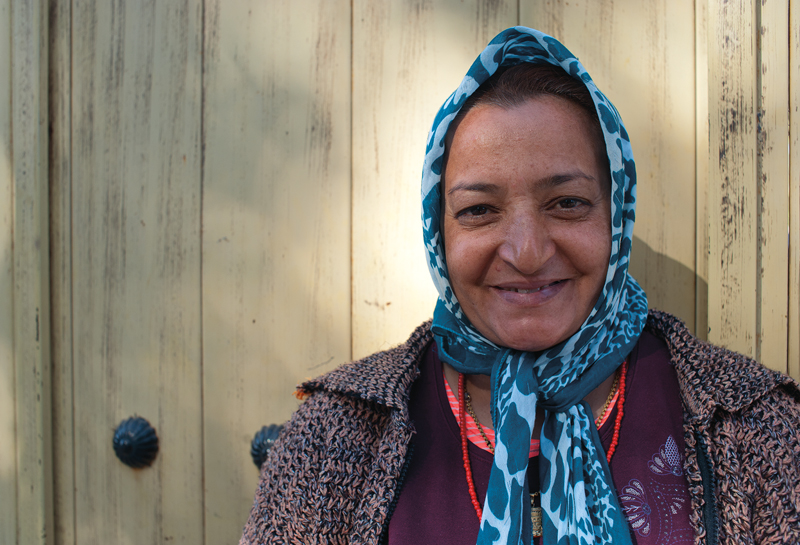
East of Shiraz, Iran—My hosts at this farm east of Shiraz were Afsar, pictured here, and her husband, Abbas. Afsar taught me how to make Farmstead Winter Soup (see recipe) and Date-Nut Halvah (see recipe). She bakes bread twice a week, milks the cow every day, and does all the cooking for her guests and for her family.
Over 60 percent of the population of Iran is Persian, most of them Shia Muslims of the Twelver sect. Some of the Persian population are not Muslim but followers of Zoroastrianism, the religion that was dominant in Iran at the time of the early Persian Empire 2,500 years ago (see Zoroaster’s Legacy).
The population also reflects peoples who lie outside its borders, for in the course of conquest, various Persian rulers, most notably Shah Abbas in the early 1600s, forcibly brought populations from elsewhere and settled them inside Iran. These included a large number of Armenians, who were settled in Isfahan, and a sizable Georgian population brought to Iran from eastern Georgia. But also over the centuries, a number of Georgians, Armenians, and others moved to Iran for trade or other reasons. Many of the Armenians have left Iran since the Islamic Revolution in 1979. And most of the Georgians have assimilated into the majority Iranian culture, although some still speak a Georgian dialect.
About 16 percent of the population is Azeri (there are disputes about the exact figure, but it’s more than twice the population of Azerbaijan). The northwest of the country, in and around the city of Tabriz, near the border with Azerbaijan, has an Azeri majority population. In roughly the same area live the remaining Assyrians of Iran, the descendants of the Assyrians who once ruled an empire centered in Nineveh before they were defeated by the Persians under Cyrus the Great. The Assyrians are Aramaic-speaking Christians. Other minority populations include the Kurds, who speak several Kurdish languages, all distantly related to Persian; the Lurs, who also speak an Iranic language and live near the southern Iraqi border; Arabs and Turkic peoples who live in the mountains of southern Iran; Balochis, who live in the southeast near the Pakistan and Afghanistan borders; and Turcomans, who live near the border with Turkmenistan.

Tbilisi, Georgia—This woman is Azeri, as are many of the women who work in the markets of Tbilisi. Like other market women in Georgia, Armenia, and Azerbaijan, she found my interest in photographing ordinary things, such as cabbages, pumpkins, and herbs, very entertaining.
Long ago, the Persians figured out how to bring water from the snowy mountains down into the desert without losing too much of it to evaporation. The technique, later adopted across central Asia, was to build underground canals, called qanats, to transport the water. The qanats enabled agriculture to flourish even in places with low rainfall. Around Kerman, in the south, there are enormous orchards of pistachio trees; in and near Yazd, in the central desert, pomegranates and other fruits grow; in the river valleys near Shiraz, there’s rice and wheat, as well as an abundance of fruits, vegetables, and herbs. To the west of Tehran, in a countryside that looks dry and rocky, people are now growing olives, a relatively new crop in Iran, on a vast scale for olive oil.
Early cookbooks written for the court of the Caliphs after the conquest of the Persian Empire by the Arabs contain detailed recipes for rice and meat and vegetable dishes, as well as desserts. Because the Arabs took on many aspects of Persian culture, including cuisine, it is remarkable how many of the elements of those early recipes are still present in modern-day Iranian dishes. At the same time, the arrival of vegetables and fruits from the New World, such as tomatoes, potatoes, and various legumes, has expanded the range of ingredients available to home cooks.
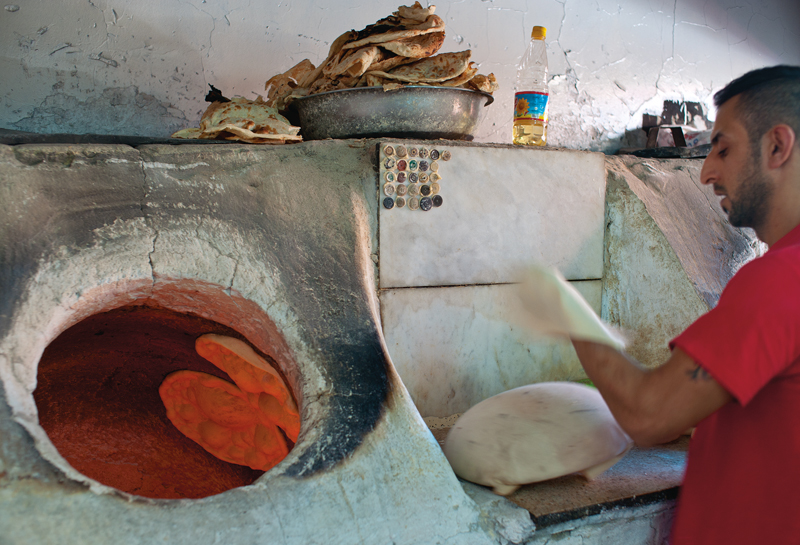
Ainkawa, Kurdistan—A baker in the Assyrian suburb of Kurdistan’s capital, Arbil, about to place stretched dough onto a baker’s pillow. He’ll slap the dough from the pillow onto the hot wall of the tandoor oven. Each flatbread bakes in about four minutes.
The area I call Kurdistan in this book is formally part of Iraq and is often known as Iraqi Kurdistan. It lies in part of what was, for centuries, called Mesopotamia—the land between and near the Tigris and Euphrates Rivers—and has long been invaded and fought over. Kurdistan’s capital, Arbil (its Kurdish name is Hawler), is one of the oldest continuously inhabited cities in the world. These days it is Kurdistan’s oil that has given it some autonomy and power. In earlier times, it was the fertile soil, with water from nearby rivers to make the land productive, that made the region so attractive to invaders.
The majority population is Kurdish, part of the large population of Kurds who live in what is known as Greater Kurdistan, an area that includes part of many neighboring countries: Turkey, Iran, Armenia, and Syria, as well as Iraqi Kurdistan. Iraqi Kurdistan is the closest the Kurds have ever come to having an independent country. There are three different but related Kurdish languages spoken in Iraqi Kurdistan; Kurdish is an Indo-European language in the same family as Persian.
Traces of earlier populations and eras remain in Kurdistan: Many Assyrians live there, some in small villages and some in and near the capital, Arbil. There are also Assyrians living in neighboring Iran and in Turkey. The Assyrians were early converts to Christianity and have been persecuted over the centuries by many rulers and conquerors, from the Mongols to the Ottomans. The Yazidis are another distinct group in Kurdistan, also much persecuted over the centuries. Their home church is in Lalish, in Kurdistan, and large populations lived in other parts of northern Iraq, including Sinjar, until the invasion by ISIL. There are also significant populations of Yazidis in Turkey, Syria, and Armenia. (For more about the Yazidis, see Glossary.)
For years, from the early 1970s on, the Kurds, along with the Assyrians, Yazidis, and other minorities in Iraq, faced persecution and attacks by Saddam Hussein. He fought a brutal war against the Kurds and used weapons of every kind, including chemical weapons, against the civilian population.
Things changed after the First Gulf War: Kurdistan gained autonomy when the Allies created a safe haven there in 1992. That enabled the Kurdish majority to take control of oil production and to develop a local economy largely independent of the rest of Iraq. Goods and food are traded across the border with Turkey and with Iran. And a still-corrupt but functional democracy has taken root. Although the majority population is Sunni Muslim and fairly conservative, modern Kurdistan is determinedly secular.
Because Kurdistan is landlocked and the Kurds there, as in Iran and Turkey, have long had second-class status and faced persecution, much of village and rural Kurdistan remains fairly traditional and socially conservative. Most women wear long dresses over pants and cover their heads with light scarves. Religious observance, such as regular prayer and abstention from alcohol, is still the norm for most Kurds.
Until recently, life was so unstable that many had no opportunity for higher education and little contact with the outside world. That is now changing, as oil wealth and local autonomy have enabled villagers to send their children to college and as social media and increased education have had an impact on people’s awareness of the rest of the world.
Note: Recent events in Iraq and Syria have meant that Kurdistan’s army, the Pesh Murga, has been engaged in fierce warfare with the invading forces of ISIL since June 2014. Even before that, a large number of Kurdish refugees from the civil war in Syria had fled to Kurdistan, and since then, thousands of refugees from the rest of Iraq have sought safety in Kurdistan.
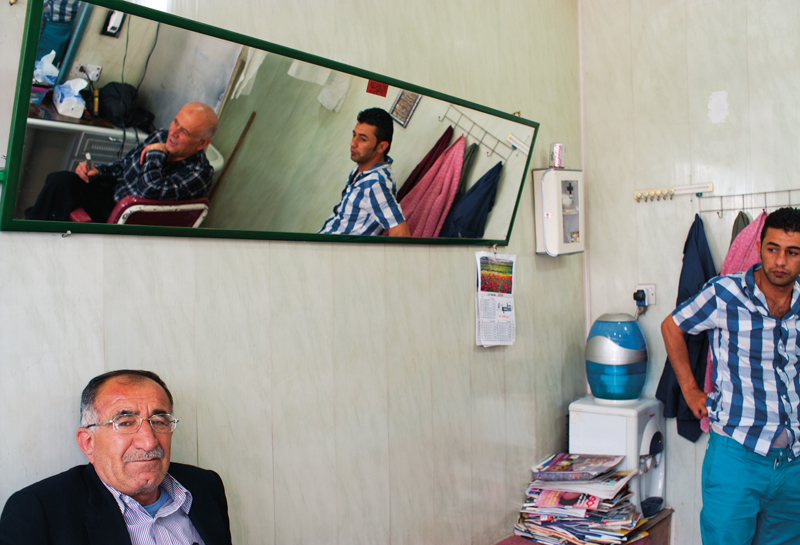
Sulaymaniyah, Kurdistan—I love photographing barbershops with their mirrors and interesting reflections.
As with many neighbors, there’s mistrust among the three Caucasus nations. The Azeris and Armenians fought a war over the mountainous territory of Nagorno-Karabakh in the 1990s; they are now in a cease-fire but still actively hostile. And as small countries surrounded by larger powerful neighbors—Russia, Iran, and Turkey—they are all understandably concerned about their security. The Caucasus countries have a long, painful history of being invaded or ruled over by everyone from the Byzantines and the Persians to the Russians and the Ottomans.
At the same time, there’s a vibrancy. Armenians and Georgians each speak a distinctive language that has survived invaders and conquerors for several thousand years, including the oppressions of the Soviet Union. The fall of that empire in the early ’90s—the destruction of one pattern and the emergence of the individual nation-states of Armenia, Azerbaijan, and Georgia—was both painful and exciting. People lost jobs and security as Soviet industries crumbled or were sold off to enrich the oligarchs, yet that first feeling of having their own country, rather than being ruled from Moscow, was exhilarating for many.
More than twenty-five years later, after various traumas—not just the Nagorno-Karabakh war but also Georgia’s two conflicts with Russia (Abkhazia and South Ossetia), and massive and growing inequality of income in all three countries—the future is a little murky.
But what people do know will endure and what they are proud of are their cultural traditions, among them, having a place of honor, their food traditions.
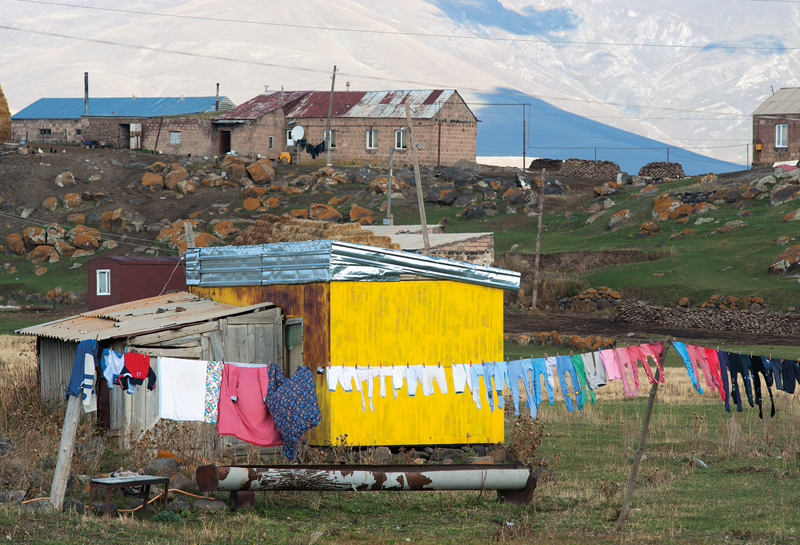
Raya Taza, Armenia—Snow-covered peaks rim the horizon that frames this small scattered farm village about two and a half hours’ drive from Yerevan. The people here are Yazidi (see Glossary). Other hamlets in the area are Kurdish or Armenian.
Like the rest of the region, Armenia, called Hayastan in Armenian, has a long history (and prehistory), evidence of which, including sophisticated Urartian metalwork from over 2,600 years ago, is on display in the National Museum in Yerevan.
The majority of Armenia’s 3 million people are ethnically Armenian and Christian, following the Armenian Apostolic Church. Since the country became independent from the USSR, the church has become a force for nationalistic expression. The Armenian language is an ancient one, Indo-European, with an alphabet that was created by the much-revered Mesrop Mashtots in AD 405, around the time that Christianity displaced Zoroastrianism and animism and became the national religion of Armenia. Literacy and libraries and education are still a vital part of Armenian culture.
There are other peoples in Armenia too: small populations of Russians and Kurds, as well as Yazidis (see Glossary). The Kurds and Yazidis live in villages on the high plateau. They are the descendants of villagers who fled to Armenia from eastern Turkey during the genocidal attacks by Turks on populations of Armenians, Yazidis, Kurds, Assyrians, and others, in the nineteenth and early twentieth centuries.
Since the breakup of the Soviet Union, Armenia has been an independent democratic country, and one with severe economic challenges. The economic situation is not helped by Armenia’s long-running dispute with neighboring Azerbaijan over the mountainous area called Nagorno-Karabakh. The dispute, which erupted into war in the nineties and is now holding as a cease-fire, resulted in the killing of civilians on both sides and the disentangling of populations who had once been intermingled: The many Armenians who had lived for generations in the Azeri capital, Baku, and in other towns fled to Armenia, and the Azeris who had been living in Nagorno-Karabakh, and in Yerevan and other Armenian towns, fled to Azerbaijan. Nagorno-Karabakh is now controlled by Armenia (though the international community considers it still legally part of Azerbaijan); all border crossings between the two countries are closed.
Because Armenia is landlocked and has open borders with only Georgia and Iran, opportunities for trade and economic development are very limited. Recently small IT companies have started up in the Gyumri area, but apart from that, and the remittances that some Armenian expats send to Armenia, the economic picture is gloomy. As a result, many young and middle-aged Armenians, especially those living in villages, move either to Yerevan in search of work and the chance of advancement or to Russia to start afresh.
Most of Armenia is high plateau, overlooked by beautiful snowcapped mountain peaks. (Mount Ararat, the symbol of Armenia, and known as Massis in Armenian, is over 16,000 feet high. Its snow-covered peak floats on the horizon south of the capital, Yerevan, but it has been entirely inside the border of Turkey since the Turkish-Armenian War of 1920.) In and near the fertile river valleys, especially that of the Arax (sometimes written Aras) River, which marks Armenia’s border with Iran and Turkey, tender fruits including apricots, grapes, peaches, quinces, pomegranates, and mulberries grow well, but in the upland areas, with their harsher climate, grazing of sheep and cattle and cultivation of hardy vegetables and fruits are the main agriculture.
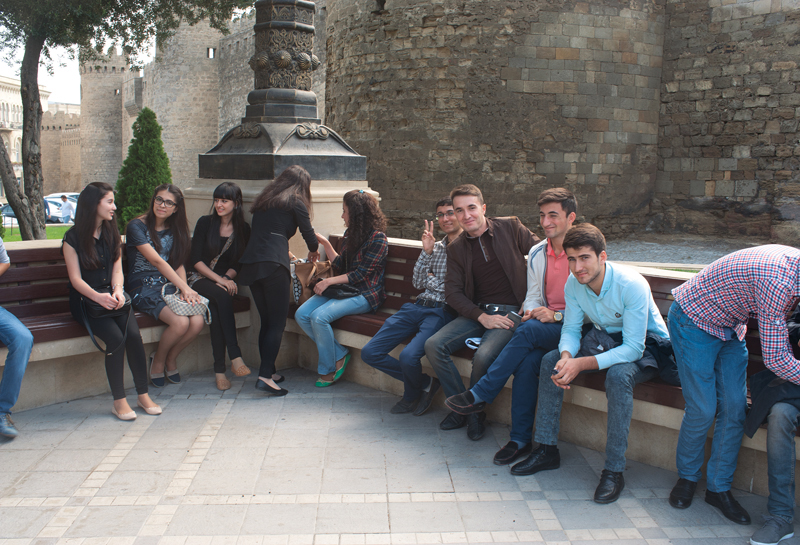
Baku, Azerbaijan—These university students were hanging out in a park that lies just outside one of the gates of the walled old city.
A large proportion of Azerbaijan’s nine and a half million people lives in and near Baku, the capital, which is located on the shore of the Caspian Sea. This is where the oil is, both in the area around Baku and deep under the Caspian Sea. (Oil still seeps out of the ground in the Baku area and burns with a flickering blue flame, as it has done for millennia, since before the time of Alexander the Great.)
Starting at the Caspian coast, Azerbaijan’s southern borders are with Iran and, farther west, with Armenia and Turkey. But those borders are complicated: If you look at the map here, you’ll see the exclave called Nakhchivan, a separate part of Azerbaijan that lies between Armenia and Iran. It is a remnant of the balkanization of borders in the Caucasus that is a legacy of the Russian and Soviet eras, and a continuing cause of friction.
Because most of its territory is low-lying, Azerbaijan has been on the route taken by conquerors arriving from central Asia from the time of the early Medes and Scythians to the Mongols and Seljuk Turks. They would travel across the south of what is present-day Turkmenistan, come into Iran, move along the southern edge of the Caspian Sea, and then go north and west into Azerbaijan. We know from archaeological sites that humans lived along the Caspian coast well before those invaders of the last three thousand years. The petroglyphs in Gobustan, near Baku, which depict people hunting, herding goats, and paddling large boats, are Mesolithic; other sites date from even earlier.
Russia defeated Persia and took full control of the three Caucasus countries—Azerbaijan, Armenia, and Georgia—in 1828. Nearly a century later, as the Russian Empire fell apart during the Russian Revolution in 1917–18, Azerbaijan, together with the Azeri part of northwest Iran, declared itself an independent republic. But by 1920, Soviet Russia had taken military control of present-day Azerbaijan (and Iran had reasserted control over the rest of the Azeris). From then until the breakup of the Soviet Union in the early 1990s, Azerbaijan was part of the USSR. Since then it has established itself as an independent country. Azerbaijan is staunchly secular and ruled by an authoritarian regime that is famous for its corruption.
Azerbaijan’s ongoing dispute with Armenia over the territory of Nagorno-Karabakh (see Armenia, for details) means that the country has closed its borders with Armenia and that the Armenians who used to live in Baku and other towns have left. The mirror to this is that Azerbaijan has had to absorb Azeri refugees who fled Armenia and Nagorno-Karabakh during and after the war.
Most Azeris’ mother tongue is Azeri, a Turkic language that is laced with words of Persian origin. The alphabet is Roman, but with more letters, rather like the alphabet used in Turkey. Because of the country’s long domination by Russia, many older Azeris speak Russian, and it is still widely taught in the schools. There are also populations whose first language is not Azeri but one of the Tat languages. Tat is a family of Iranic languages, a remnant of the languages spoken in the region before the invasion of Turkic peoples from the eleventh century onward. Tat languages are spoken by the people of Lahich and several other villages in the foothills of the Caucasus.
Azerbaijan’s enormous oil wealth is largely concentrated in Baku and among the few who form the Azeri elite. The result is that in the towns and villages outside Baku, people are educated but live frugally on relatively low incomes, and with inadequate infrastructure.
Azerbaijan is rich in agricultural produce: rice and tea, fruits and vegetables. Herds of dairy and beef cattle, as well as sheep and goats, graze on the slopes of the Caucasus foothills.
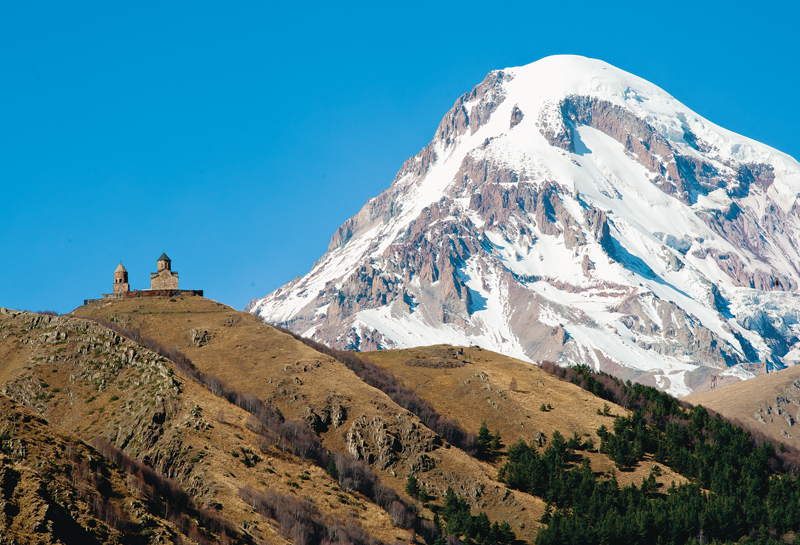
Kazbegi, Georgia—Gergeti Holy Trinity Church is perched high on a mountain shoulder below Mount Kazbek, at 16,512 feet the third-highest mountain in Georgia. A few miles further up the road, called Russian Military Highway, lies the border with Russia.
In Georgian, the name for the country is Sakartvelo. The population is majority Georgian, but with strong regional differences in language and culinary traditions. Sizable Armenian and Azeri populations live in the capital, Tbilisi, and in other cities.
The Black Sea coast is lush and fertile. Its principal city is the port of Batumi. (Abkhazia, on the Black Sea coast, separated from Georgia in the 1992–93 war. Georgia’s remaining coastline is less than a hundred miles long.) Most of Georgia’s northern border is with Russia, at the Caucasus Mountains. On the south, it borders Turkey and Armenia, and to the east lies Azerbaijan. For sixty years, the southern border with Turkey was the border between the West and the USSR and thus was a heavily fortified military zone. The area is still populated by a mix of Russians and Armenians, with Georgians a minority.
Georgians speak a language that is non–Indo-European and is related to only a few other Caucasus languages. The earliest Georgian alphabet dates back at least to the fourth century, and possibly before. As in Armenia, literacy and education are important elements of Georgian culture. Since independence, the Georgian Orthodox Church has become a vehicle for the expression of nationalism, often of a narrow and intolerant kind.
Like Armenia and Azerbaijan, Georgia had its own local kings and rulers but was also under Persian rule intermittently for centuries, until it came under Russian control in the early nineteenth century. In 1921, the country was forcibly incorporated into the USSR; it gained independence when the Soviet Union broke up in the early ’90s. Since then, there have been two wars along Georgia’s northern border. Georgians view both—the breakaway of the region called Abkhazia and the secession of South Ossetia—as troubles instigated by Russia, the Goliath that lies across the Caucasus Mountains. Georgia is now a relatively stable, if economically vulnerable, democracy.
The country has a long history (and prehistory), with archaeological sites yielding evidence that the Georgians may well have been the first people to know winemaking. Like the Armenians and the early inhabitants of Azerbaijan, the early people of Georgia cultivated wheat and other grains and legumes.
Because the country has many distinct climatic zones and regions isolated by rough terrain (rather like Switzerland), the food has a strong regional identity. Most Georgian dishes have very specific regional origins. Rather like in parts of Italy even now, people identify with their home region and local cuisine and speak a regional dialect.
Georgia’s culinary regions can be divided roughly between the west, with its abundance of fruit of every kind, a greater reliance on corn, and more intense seasonings, especially in the mountainous regions of Svaneti and Racha (more raw garlic and a liking for black pepper and chiles, for example) and the east, with its vineyards, preference for wheat breads, and milder, more subtle layering of flavors. That division mirrors a period long ago, when control of what is now Georgia was split between the Byzantine Empire, which held western Georgia, and the Persians, who ruled the rest (along with the territories of present-day Azerbaijan and Armenia).